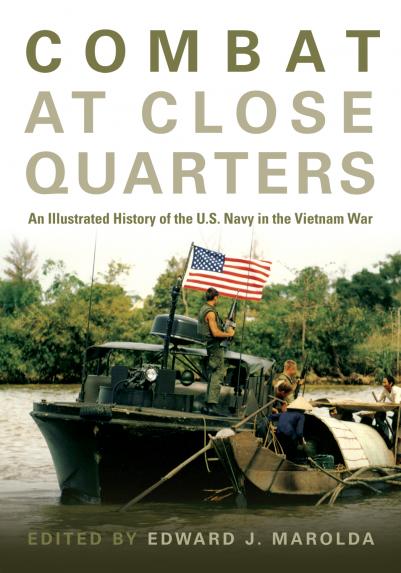
Combat at Close Quarters: An Illustrated History of the US Navy in the Vietnam War. Edited by Edward J. Marolda. Naval Institute Press, Annapolis, 2018.
Reviewed by David Hobbs
IT is now more than half a century since President Lyndon B. Johnson ordered the commencement of Operation ROLLING THUNDER, the US bombing campaign that was intended to discourage the Hanoi regime’s direction and support for the insurgency by the Viet Cong against the Republic of Vietnam.
The conflict in South-East Asia that followed became one of America’s longest wars but until recently a great deal of information remained classified and it was difficult for historians to obtain a completely accurate over-view of operations. ‘Combat at Close Quarters’ has evolved from a number of ‘booklets’ commissioned by the Naval Historical Foundation and the Naval Historical Centre (now the Naval History and Heritage Command) which were written by highly-regarded authors using newly de-classified material as it became available. Edward Marolda, Head of the Historical Centre, and Sandra Doyle managed the project from 2003 and their work resulted in the publication between 2009 and 2017 of nine short histories. Their subject matter included the USN’s increasing connection to South-East Asia after 1945, the POW experience in Vietnam, Navy medicine in Vietnam, sealift and logistic support and the final evacuation from Vietnam.
Ed Marolda picked a further four topics from the original nine for inclusion in this work in slightly modified form to give a detailed analysis of the bombing campaigns, in which carrier-borne aircraft played a considerable part, riverine warfare and naval intelligence. In addition to editing the whole work and overseeing its publication by the US Naval Institute he contributed to three of the subjects and co-ordinated the work of four other authors, Norman Polmar, R. Blake Dunnavent, John Darrell and Richard A. Mobley. The resulting book gives a gripping account of naval operations during the Vietnam Conflict that is both very well researched, fascinating to read and supported by over 200 photographs, many of them in colour and a number of maps. Insets give excellent descriptions of naval aircraft and weapons together with short biographies of significant people to support the main text. Royal Australian Navy destroyers that took part in Operation Sea Dragon, operating alongside USN warships off the North Vietnamese coast, are mentioned in their due place, as is the ‘friendly fire’ incident involving HMAS HOBART when she was hit by a missile fired by a US Air Force aircraft off the coast of southern North Vietnam.
Ed Marolda and his authors do not shrink from giving their blunt appraisals of the overall direction of the war from Washington. ‘The Johnson administration’s mismanagement of the Rolling Thunder campaign that ended in failure’ is one example on page 73 and on page 58 the description of how Admiral Ulysses S G Sharp, Head of the Pacific Command, ‘began to part ways with Johnson and McNamara as it became clear from 1966 to 1968 that the administration’s handling of the war was inept, was costly in terms of American lives, and would not defeat the enemy’. Secretary of Defence Robert S McNamara comes in for considerable and justifiable criticism throughout the book for his failure to take advice from senior officers or to comprehend the factual basis for the structure and deployment of armed forces.
The book brings new clarity to the way in which the conflict spread to Laos and Cambodia as means were sought to cut North Vietnamese supply routes to the Viet Cong in the south and it is interesting to learn of the difficulty encountered by the naval intelligence community in Vietnam as it tried to convince the administration in Washington that large quantities of weapons and ammunition were actually arriving by sea. At the end of the Vietnam War many analysts in the USA described it as an aberration and gave it as their opinion that what they described as ‘limited war’ was unlikely to recur in an age of stealth bombers, ballistic missiles and nuclear weapons. In fact, the conflict has proved to be typical of a succession of conflicts, both in terms of its direction and combat operations, in the late twentieth and early twenty-first centuries. These have involved the navies of the USA and her allies in confrontations with non-traditional adversaries in distant regions of the world and projecting conventional power ashore in such places as Lebanon, Panama, Kosovo, Afghanistan and Iraq. It is, therefore, particularly important that we understand the conflict in South-East Asia from every aspect; what went right and of course what the administration did wrong, if we are to fully comprehend the contemporary roles of navies in limited warfare and how best to make use of them. Ed Marolda has edited a outstanding work by several authors who are all experts in their field. It is full of factual detail and careful analysis that makes use of the most recently de-classified documents and the opinions of men who were there at the time. It provides the wider picture that complements the history of RAN warships that served alongside their USN allies in the Vietnam War and does so in a way that is both stimulating and of absorbing interest. I thoroughly recommend it.



